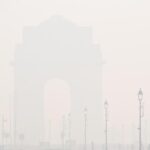Policy is only as strong as the credibility of the data it rests on. In recent months, two failures in India’s environmental monitoring systems have raised disturbing questions of governance — Delhi’s Real-Time Air Pollution Network and Lucknow’s National Ambient Noise Monitoring Network. Both were launched with fanfare, but their scientific weaknesses erode not only public trust but also India’s international credibility.
For decades now, it has been evident that the air in Indian cities is unfit to breathe, with Delhi ranked as the worst. Yet, audits and inquiries, including the recent Comptroller and Auditor General of India report reveal flaws in the monitoring network at multiple levels. Several sensors are placed under tree cover, behind walls or obstructions. More recently, the Delhi government has proposed installing sensors in relatively less polluted locations. Official data often report air quality as “moderate”, while citizens gasp for breath in toxic smog. This is not a matter of technical deficiency alone but raises a fundamental question of governance. When evidence itself is unreliable, on what basis can public pollution policy stand?
The importance of sound data
Every action plan for Delhi, whether on stubble burning, vehicular restrictions or industrial emissions, must rest on robust and scientifically sound data. If the very data are not representative or distorted to understate pollution, it is not only the policies but also their direction that stands compromised. Weak monitoring risks India’s global commitments (Paris Agreement, World Health Organization (WHO) Air Quality Standards), and priorities in the process.
In Lucknow, the situation is no different. In 2017, the average noise pollution levels in seven Indian cities exceeded the limits set by the Central Pollution Control Board (CPCB). In 2017, the former Environment Minister, Anil Madhav Dave, in the Rajya Sabha, highlighted serious flaws in India’s urban noise-control policy. The noise monitoring network was flawed from the outset, with sensors failing to capture actual decibel levels. India continues to rely on the outdated Noise Pollution (Regulation and Control) Rules, 2000, which has been criticised as being inadequate. The decibel limits fall short of WHO guidelines, enforcement is weak, and penalties carry little deterrence.
Technology is deployed as spectacle without scientific discipline. Shiny hardware without rigour breeds opacity. Misleading data downplay hazardous levels as merely “moderate.” In a democracy, misleading the public on health is deeply troubling. Governance becomes a contest between citizens and industries: flawed numbers favour inaction and the voices of citizens demanding protection under the right to health and life are suppressed.
In Delhi, misleading Air Quality Index often delays judicial intervention. In Lucknow, inaccurate noise data weaken fundamental rights under Articles 19 and 21. The judiciary too has begun to acknowledge this. In a recent order, the Supreme Court of India transferred pleas highlighting noise pollution around Delhi Airport to the National Green Tribunal, underscoring that such disputes demand specialised adjudication. This recognition makes it clear that noise is no longer a nuisance but a constitutional and public health issue.
The missing pillars
The CPCB does have clear guidelines on sensor location, calibration and periodic audits. But enforcement is lax by design, political pressures abound, and independent scientific scrutiny is nearly absent.
The irony is glaring. Class-1 quality sensors for air and noise monitoring are installed at enormous public expense by the CPCB under the aegis of the Environment Ministry. There is no independent panel to review monitoring systems as in international norms. Without third-party audits and transparent processes, public trust in official data will continue to erode.
The latest Air Quality Life Index report (Energy Policy Institute) shows that if Delhi’s air met WHO standards, average life expectancy could rise by 8.2 years. Across India, pollution silently erodes life expectancy by close to five years. The jugglery by agencies with misleading data diverts focus from accountability
This debate is not about devices but about people’s health. Fresh scientific evidence shows that exposure to pollutants such as nitrogen dioxide (NO2) and fine particulate matter (PM2.5) weaken lungs and accelerate myopia. When air quality indices misrepresent reality, children with asthma are exposed to unsafe air. Likewise, flawed noise monitoring leaves infants and the elderly unprotected. Behind every misleading index or incomplete dataset lies preventable harm.
Science as the foundation
For monitoring to inspire trust, science must guide its foundation. Install sensors strictly according to standards with independent experts. Keep raw data open, enable routine third-party audits and create formal citizen oversight.
The experiences of Delhi and Lucknow are a warning: environmental monitoring cannot be treated as a bureaucratic formality. Real-time technology is meaningful only if it reflects reality. In India’s rapid urbanisation, environmental data will shape policy, inform the public and represent the nation globally. If the data regime is misleading, the price will be paid not in reports but in children’s lungs and the sleepless nights of citizens. Scientific rigour, transparency and public trust must be the bedrock of India’s environmental monitoring revolution. Otherwise, real-time networks will turn into real-time deception.
Rohan Singh is an independent journalist covering urban environment, governance and urban public health in India. Kushagra Rajendra currently heads the Environment and Sustainability domain at Amity University, Haryana
Published – October 22, 2025 12:08 am IST

